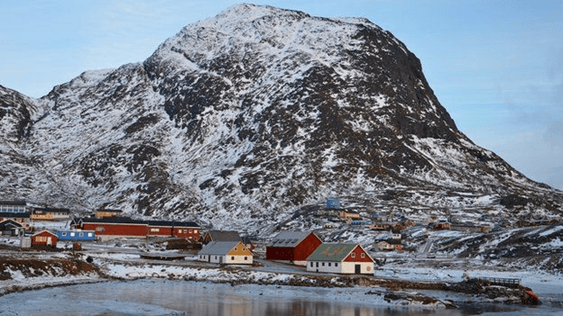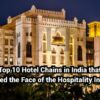Greenland was significant during World War II despite its steep mountainous landscapes, unknown inhabitants, lack of electricity, and challenging Arctic climate. Even today, the island country is in the limelight for bearing the potential of being the most profitable source of Europe’s Rare Earth Element (REE). Let’s look at Greenland’s history and its historic Ivigtût mine with high-grade REE.
Greenland – The Strategic Hotspot During WWII
Greenland played a significant role during World War II. It was the host to several allied military bases enabling communication, navigation, and the transportation of goods between North America and Europe. The island country was, therefore, a significant link in the North Atlantic air ferry route during World War II.
A U.S. military naval base was built at the head of Arsuk Fjord village, now the headquarters of the Danish navy’s Arctic Command at Grønnedal (Kangilinnguit).

REE Potential in Greenland
Rare Earth Elements (REEs) are essential and non-substitutable raw materials for emerging renewable energy resources and high-tech products, devices, and technologies with widespread applications in the medical, aerospace, defence, and automobile industries. The most abundant mineral sources of REEs, especially light REEs (LREE), are bastnäsite and monazite.
Greenland, the island country, is rich in several large REE deposits in various geological settings. Some of the largest REE deposits are found in the peralkaline intrusions related to the Gardar Province in south Greenland, covering the deposits around Kvanefjeld, Kringlerne, and Motzfeldt Sø.
Several carbonatite-associated REE deposits are found in Greenland, most notably the:
- Sarfartôq carbonatite complex,
- Qaqarssuk carbonatite,
- Tikiusaaq carbonation.
Greenland has the potential to meet the increasing global demand and become a significant exporter of REE to reduce dependence on China.
What are Rare Earth Elements?
Rare earth elements are a group of 17 elements on the periodic table that include 15 lanthanides (La–Lu): Lanthanum (La), Cerium (Ce), Praseodymium (Pr), Neodymium (Nd), Promethium (Pm), Samarium (Sm), Europium (Eu), Gadolinium (Gd), Terbium (Tb), Dysprosium (Dy), Holmium (Ho), Erbium (Er), Thulium (Tm), Ytterbium (Yb), Lutetium (Lu), 1 Scandium (Sc) and 1 Yttrium (Y).

RARE EARTH ELEMENTS IN THE PERIODIC TABLE
- REEs are typically divided into light rare earth elements (LREE) and heavy rare earth elements (HREE). Some elements of this group are widely used as vital components in modern technology.
- REEs like Neodymium (Nd), Dysprosium (Dy), and Praseodymium (Pr) are widely used in wind turbines for high-strength magnets, hard disk drives, and engines in electric cars.
- Elements like Europium (Eu), Yttrium (Y), Terbium (Tb), Lanthanum (La), and Cerium (Ce) are used in phosphor-based fluorescent lighting, smartphone screens and batteries.
The Historic Ivigtût Mine
Ivittuut or Ivigtût, a town in southwestern Greenland, is a spectacular source of rare earth minerals. Ivigtût is known for being the world’s largest reserve (a large open-pit cryolite mine) of naturally occurring cryolite, used for modern aluminium extraction.
Explorations at Ivigtût began in the 1700s and 1800s. Significant mining of mineral ores started in the 1900s. However, the mineral investigations were minor compared to the present.
As cryolite was used in fighter plane manufacturing, Ivittuut became a crucial site for cryolite mining during WWII. Though Denmark operated the mine, the U.S. guarded the area against the Nazis so the allies could mine the cryolite. The U.S. military naval base was built at Arsuk Fjord, now the headquarters of the Danish navy’s Greenland Command at Grønnedal.

Less than 10km from Ivigtût is the Grønnedal carbonatite complex, which has been one of Greenland’s 12 more significant Gardar alkaline intrusions. The Grønnedal carbonatite complex is recognised by GEUS (Geological Survey of Denmark and Greenland) as one of Greenland’s prime REE targets along with Kvanefjeld and Kringlerne (Tanbreez).
Eclipse Metals: Exploring REEs in Greenland’s Ivigtût Mine
Eclipse Metals Ltd (ASX: EPM), the Australian mineral exploration and mining
development company, currently owns the historic Ivigtût mine. The company acquired full ownership of the Ivigtût Project in 2021 which includes the historical mine site and the Grønnedal carbonatite complex. Eclipse aims to take the project forward as a multi-commodity project by exploring REE and High-Purity Quartz (HPQ) prospects.

IVITTUUT (IVIGTÛT) PROJECT IN GREENLAND
Apart from Greenland, Eclipse has a diversified asset projects portfolio across minerals such as manganese, gold, uranium, vanadium, and precious metals in Australia.
Eclipse Metals announced the final REE laboratory assay results for nine grab samples from Ivigtût and Grønnedal in March 2022. The results indicated highly anomalous Total Rare Earth Oxide (TREO) up to 4.66%, with additional by-products of niobium (Nb) in Grønnedal, and lead (Pb), copper (Cu), zinc (Zn), and silver (Ag) in Ivigtût.
The results indicated the presence of several distinct styles of REE mineralisation, such as the Carbonatite-hosted REE mineralisation enriched in Dysprosium (Dy), Praseodymium (Pr) and Neodymium (Nd).
The Executive Chairman of Eclipse Metals, Carl Popal, said, “Our grab sampling program has once again verified the potential of both Ivigtût and Grønnedal to host REE mineralisation as well as precious, base and industrial metals, which is very encouraging, especially as the demand for REEs, in particular, dysprosium, neodymium and praseodymium, as well as niobium continues to grow.”
Eclipse Metals is progressing with its drilling and sampling program at Ivigtût, along with activities in the Ivigtût mine precinct and Grønnedal carbonatite complex.
Disclaimer











